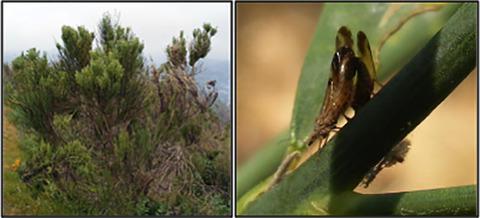当前位置:
X-MOL 学术
›
Plant Pathol.
›
论文详情
Our official English website, www.x-mol.net, welcomes your
feedback! (Note: you will need to create a separate account there.)
Ecology‐based analysis of a recent association between Spartium junceum and 16SrV phytoplasma
Plant Pathology ( IF 2.3 ) Pub Date : 2020-10-22 , DOI: 10.1111/ppa.13300 Serena Rizza 1 , Marika Rossi 2 , Rosa E. Spallino 1 , Rosemarie Tedeschi 3 , Cristina Marzachì 2 , Vittoria Catara 1 , Matilde Tessitori 1
Plant Pathology ( IF 2.3 ) Pub Date : 2020-10-22 , DOI: 10.1111/ppa.13300 Serena Rizza 1 , Marika Rossi 2 , Rosa E. Spallino 1 , Rosemarie Tedeschi 3 , Cristina Marzachì 2 , Vittoria Catara 1 , Matilde Tessitori 1
Affiliation

|
An outbreak of Spartium witches’ broom (SpaWB) in Sicily prompted us to identify and characterize associated phytoplasmas. Over 80 samples of Spanish broom (Spartium junceum) and around 270 individuals of the potential vector Livilla spectabilis were collected and analysed. Single and mixed infections of 16SrV and ‘Candidatus Phytoplasma spartii’ were detected in Spanish broom samples and for the first time in L. spectabilis. The 16SrV isolates were further characterized by multilocus sequence typing (MLST) to determine their phylogenetic relationship with flavescence dorée phytoplasma (FDp) and to evaluate the risk of host‐jumping to grapevine. Phylogenetic analysis of most of the analysed genes using the MLST approach grouped S. junceum 16SrV‐C isolates with FDp isolates infecting grapevine and Scaphoideus titanus. Notably, phylogenetic analysis of the vmpA gene clustered the S. junceum isolates with FDp genotypes transmitted by S. titanus. This study extends the knowledge of SpaWB epidemiology, focusing on the possible risk of a 16SrV host jump from Spanish broom to grapevine. Spanish broom was identified as a reservoir and potential inoculum source of phytoplasmas that cause severe disease in cultivated crops. Furthermore, the L. spectabilis psyllid may be involved in the epidemiology of this 16SrV‐C phytoplasma, although in the absence of in vivo transmission trials. The study further confirms the strong ability of phytoplasmas to adapt to new hosts and vectors, thus leading to potential phytosanitary emergencies.
中文翻译:

基于生态学的近缘天竺葵和16SrV植物原质之间关联的分析
西西里爆发了Spartium巫婆扫帚(SpaWB),这促使我们识别并鉴定相关的植物原浆。收集并分析了80多个西班牙扫帚样品(Spartium junceum)和大约270个人的潜在媒介Livilla spectabilis。在西班牙扫帚样品中检测到16SrV和' Candidatus Phytoplasma spartii spartii'的单一和混合感染,并且在L中首次检测到。壮观。通过多基因座序列分型(MLST)对16SrV分离株进行进一步鉴定,以确定它们与黄褐变种质体(FDp)的系统发生关系,并评估宿主跳入葡萄的风险。大多数采用分组的方式MLST所分析的基因的系统发育分析小号。junceum用FDP 16SrV-C株分离株感染葡萄树和Scaphoideus TITANUS。值得注意的是,进化分析VMPA基因簇的小号。junceum分离株与由发送FDP基因型小号。泰坦。这项研究扩展了SpaWB流行病学的知识,重点研究了16SrV宿主从西班牙扫帚跳到葡萄藤的可能风险。西班牙扫帚被认为是导致栽培作物严重病害的植物质原体的储存库和潜在接种源。此外,L。尽管没有体内传播试验,但spectabilis psyllid可能参与了该16SrV-C植物质浆的流行病学研究。该研究进一步证实了植物原虫适应新宿主和载体的强大能力,从而导致潜在的植物检疫紧急情况。
更新日期:2020-10-22
中文翻译:

基于生态学的近缘天竺葵和16SrV植物原质之间关联的分析
西西里爆发了Spartium巫婆扫帚(SpaWB),这促使我们识别并鉴定相关的植物原浆。收集并分析了80多个西班牙扫帚样品(Spartium junceum)和大约270个人的潜在媒介Livilla spectabilis。在西班牙扫帚样品中检测到16SrV和' Candidatus Phytoplasma spartii spartii'的单一和混合感染,并且在L中首次检测到。壮观。通过多基因座序列分型(MLST)对16SrV分离株进行进一步鉴定,以确定它们与黄褐变种质体(FDp)的系统发生关系,并评估宿主跳入葡萄的风险。大多数采用分组的方式MLST所分析的基因的系统发育分析小号。junceum用FDP 16SrV-C株分离株感染葡萄树和Scaphoideus TITANUS。值得注意的是,进化分析VMPA基因簇的小号。junceum分离株与由发送FDP基因型小号。泰坦。这项研究扩展了SpaWB流行病学的知识,重点研究了16SrV宿主从西班牙扫帚跳到葡萄藤的可能风险。西班牙扫帚被认为是导致栽培作物严重病害的植物质原体的储存库和潜在接种源。此外,L。尽管没有体内传播试验,但spectabilis psyllid可能参与了该16SrV-C植物质浆的流行病学研究。该研究进一步证实了植物原虫适应新宿主和载体的强大能力,从而导致潜在的植物检疫紧急情况。











































 京公网安备 11010802027423号
京公网安备 11010802027423号